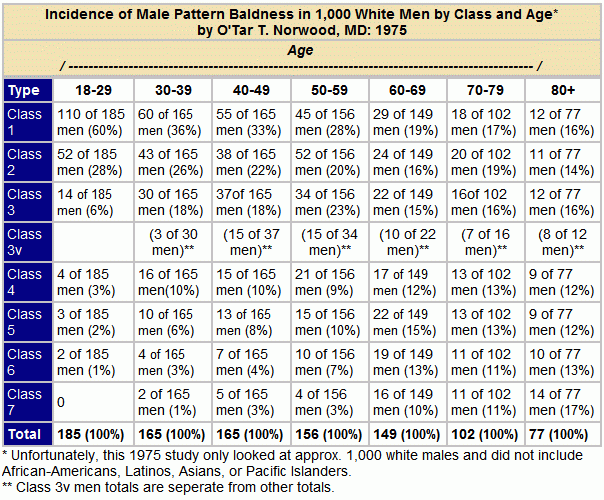Ninety-five percent of hair loss in men is caused by androgenetic alopecia, male pattern baldness. Female & Male Pattern Baldness is driven by three factors, of which the first one is the most necessary.
- Androgens (male hormones)
- Genetic predisposition
- Age
ANDROGENS
DHT and Miniaturization: It wasn’t until the 1970s or 80s that scientists began to understand that when an enzyme called 5-alpha-reductase combined with testosterone, it created dihydrotestosterone, or DHT. Dihydrotestosterone is the culprit that causes hair to fall out through a gradual miniaturization process that begins along the same patterns as outline in the Norwood Charts.
This DHT is harmful to hair follicles and “attacks” it, slowly breaking it down, reducing the diameter and length, so that the hair follicle becomes smaller and smaller while the color fades away (See diagram below). These “miniaturized hairs” are also known as vellus hair. Soon, this vellus hair will fall out and will not be replaced by new hair.”

In men, hair that grows near the temple region, front, mid-scalp (top) and crown (back top of head where it starts to go in a 90 degree angle toward the neck) are most susceptible to DHT. Hair on the back and sides of the head (above the ear but below the top, are the LEAST susceptible to hair loss.

The unfortunate circumstance that often takes place with DHT miniaturization is that actual, detectable hair loss is not evident to the individual until 40 to 50 percent of normal of their is already lost. As a result, most women and men do not seek out a doctor’s help until significant hair loss has already taken place.
Enzyme 5 Alpha Reductase: 5-Alpha reductase is a naturally occurring enzyme involved in steroid metabolism. When it combines with testosterone, it becomes dihydrotestosterone, DHT, which scientist recognize as the culprit behind male pattern hair loss. DHT attacks the hair follicles as demonstrated in the diagram above, slowly breaking them down, reducing the diameter of the follicle until it eventually falls out, never to return.
There are 2 types of 5-alpha-reductase. Type I and Type II. Finasteride only inhibits Type II 5-alpha-reductase, which means it will never be 100 percent effective in stopping DHT.
GENETICS
In 1942, Dr. James B Hamilton determined that genetic disposition was a factor in male pattern baldness. Since then, dermatologists and hair transplant doctors would often tell their patients that if you wanted to know how your hair loss pattern would look like, or how severe it would get, take a collective view of all the males in your family on both sides. However, this doesn’t answer the quantifying question of what are my chances of going bald?
A 2004 study that looked at “Family History and Risk of Hair Loss” determined that:
“…men whose fathers had hair loss were 2.5 times as likely to have had some level of hair loss compared to men whose fathers had no hair loss.
“Likewise, men whose fathers had hair loss were twice as likely to have hair loss than men whose fathers had no hair loss even after adjusting for age. Conclusion: Results suggest that the probability of male pattern hair loss is dependent on family history and age. Hair loss in a man’s father also appears to play an important role in increasing a man’s risk of hair loss, either in conjunction with a history of hair loss in the mother or hair loss in the maternal grandfather.”
AGE (& Incidence of Hair Loss)
Incidence of male pattern baldness, including crown hair loss, and age has not been definitively determined. For example, WebMD says that by age 35, 2/3 of all men will experience hair loss to some degree. By age 50, 85 percent of all men will experience thinning hair to a larger degree while an unfortunate 25 percent of young men under the age of 21 will experience some degree of hair loss.
According to the International Society of Hair Restoration Surgeons, 20 percent of men in their 20s will have hair loss, 30 percent in their 30s, and so, adding 10 percent of the population for each decade. Using this scale, 50 percent of men in their 50s will have hair loss and 90 percent in their 90s will have hair loss.
In building his hair loss classification chart, Norwood was able to get exact numbers for each chart class of hair loss based on age, (See Table below). Notice that in his findings, 3 out of 185 men (2 percent) age 18-29 are already a Class 5.
In the 40 to 49 age category, 15 of 165 men were Class 4, and 5 of 165 men were Class 7, and so on.
In the 70 to 79 group, 64 out of 102 men had Class 3 or higher male pattern baldness.

See: Norwood Hair Loss Scale for Class Images:
See Also:
Intro to Hair Loss
Hair Loss, Self-Image, & Society
Hair Anatomy
How Hair Grows
How Hair is Lost
Hair Loss in Women
Traction Alopecia
Hair Loss in Men
Norwood Hair Loss Chart
Frontal Hair Loss
How to Stop Hair Loss

